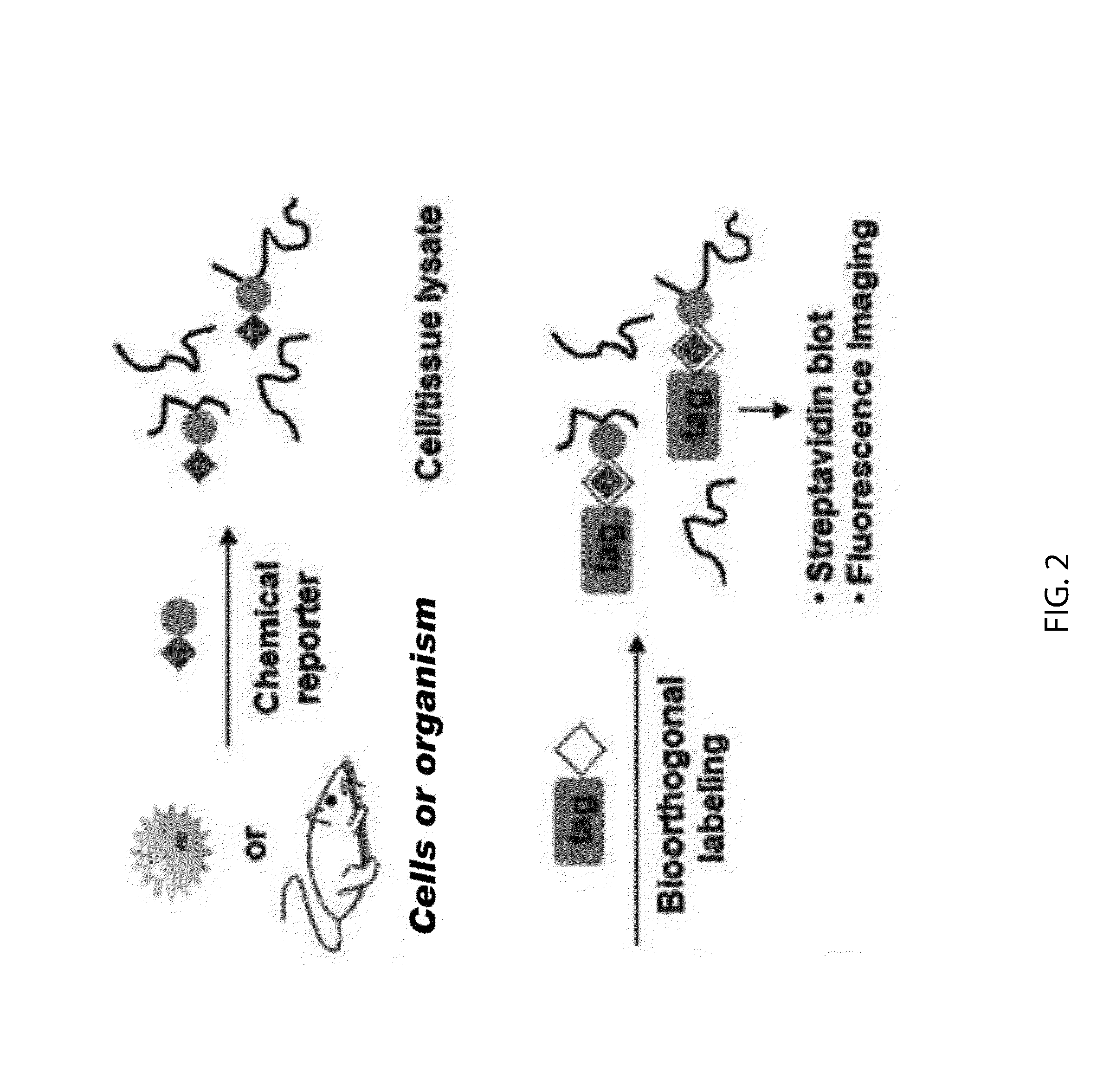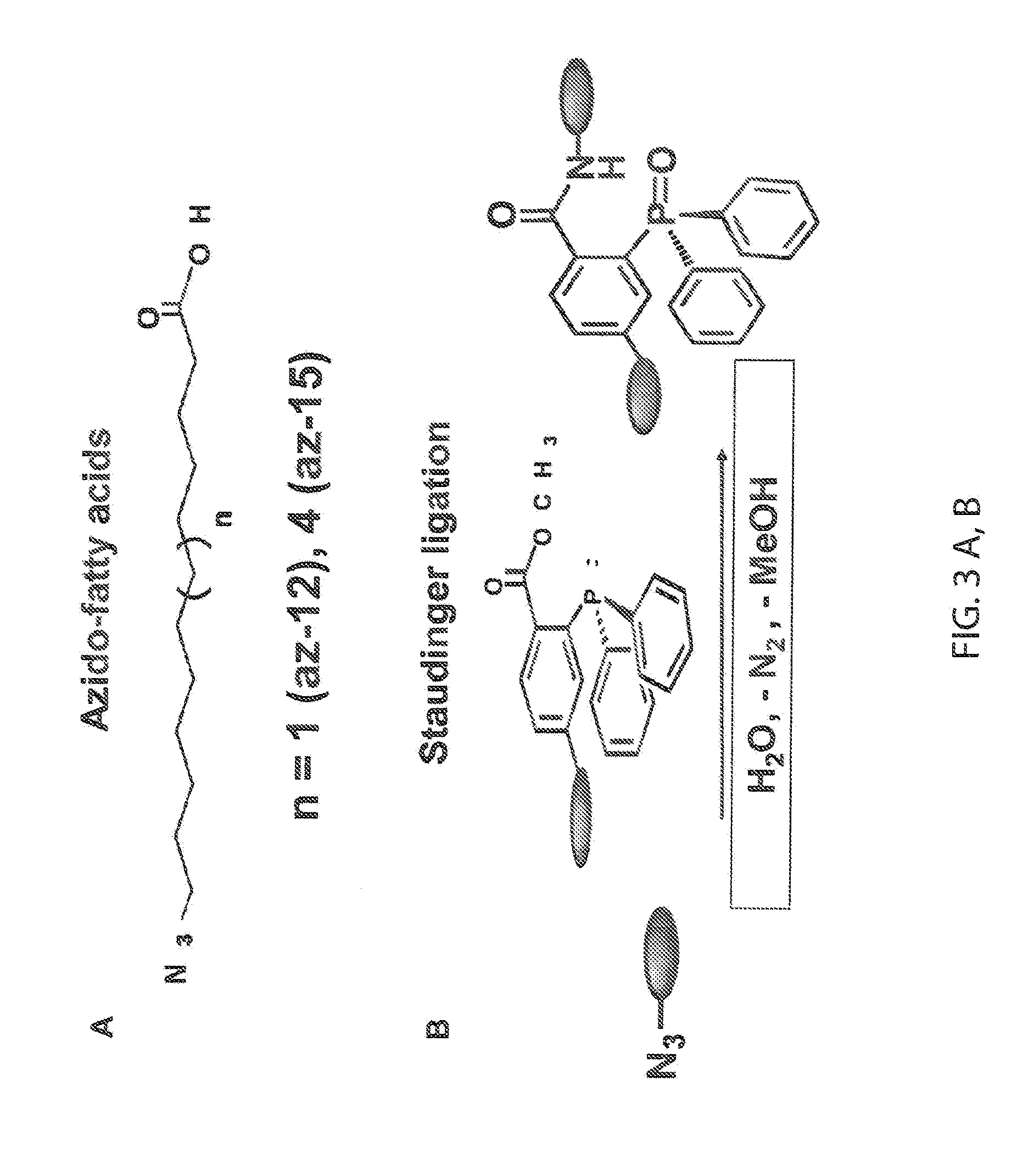Chemical Reporters of Protein Acylation
a reporter and protein technology, applied in the field of chemical reporters of protein acylation, can solve the problems of affecting the understanding of the mechanisms that regulate, unable to analyze protein lipidation, and often taking days to weeks to visualize lipidation by autoradiography
- Summary
- Abstract
- Description
- Claims
- Application Information
AI Technical Summary
Problems solved by technology
Method used
Image
Examples
example 1
Metabolic Labeling.
[0151]Jurkat cells (human T lymphoma) were cultured in RPMI medium 1640 supplemented with 10% fetal bovine serum (FBS), 100 U / mL penicillin, and 100 μg / mL streptomycin and maintained in a humidified 37° C. incubator with 5% CO2. Trypan blue exclusion was used to determine cell viability. For labeling of N-myristoylated or S-palmitoylated proteins, cells were pelleted and resuspended in either az-12 or alk-12 (20 μM, 5 mM stock solution in DMSO) or az-15, alk-14 or alk-16 (200 μM, 50 mM stock solution in DMSO) respectively in RPMI medium 1640 supplemented with 2% FBS, 100 U / mL penicillin, and 100 μg / mL streptomycin. For labeling of acetylated proteins, cells were pelleted and resuspended in alk-2, alk-3, or alk-4 (stock solution in DMSO) in RPMI medium 1640 supplemented with 2% FBS, 100 U / mL penicillin, and 100 μg / mL streptomycin. The same volume of DMSO was used as a negative control. After 4-6 hours of labeling at 37° C., the cells were pellet...
example 2
Synthesis of Chemical Reports and Detection Tags
General Procedures:
[0161]All chemicals were obtained either from Sigma-Aldrich (Saint Louis, Mo., USA), MP Biomedicals (Solon, Ohio, USA), Alfa Aesar (Ward Hill, Mass., USA), TCI America (Portland, Ore, USA), Fluka (Division of Sigma-Aldrich) or Acros Organics USA (Morris Plains, N.J., USA) and were used as received unless otherwise noted. The silica gel used in flash column chromatography was Fisher 5704 (60-200 Mesh, Chromatographic Grade). Analytical thin layer chromatography (TLC) was conducted on Merck silica gel plates with fluorescent indicator on glass (5-20 μm, 60 Å) with detection by ceric ammonium molybdate, basic KMnO4 or UV light. The 1H and 13C NMR spectra were obtained on a Bruker DPX-400 spectrometer or a Bruker AVANCE-600 spectrometer equipped with a cryoprobe. Chemical shifts are reported in δ ppm values downfield from tetramethylsilane and J values are reported in Hz. MALDI-TOF mass spectra were obtained on an Applie...
example 3
Robust Fluorescent Detection of Acylated Proteins with Chemical Reporters
[0180]Advances in bioorthogonal labeling methods employing the CuI-catalyzed Huisgen [3+2] cycloaddition or “click chemistry” reaction between alkyl azides and alkynes (Prescher and Bertozzi (2005) Nat. Chem. Biol. 1, 13-21) (FIG. 4A), suggested an opportunity to improve the analysis of acylated proteins with chemical reporters. We therefore synthesized a series of potential alkynyl-chemical reporters as well as a panel of biotinylated (alk-biotin, az-biotin) and fluorescent (alk-rho, az-rho) detection tags to explore the detection of acylated proteins with click chemistry (FIG. 15). Comparative analysis of the Staudinger ligation and click chemistry reaction with azido-labeled cell lysates and biotinylated detection probes (phos-biotin and alk-biotin, respectively) revealed significantly improved detection of acylated proteins by streptavidin blotting with the CuI-catalyzed Huisgen [3+2] cycloaddition (FIG. 8)...
PUM
| Property | Measurement | Unit |
|---|---|---|
| pH | aaaaa | aaaaa |
| concentrations | aaaaa | aaaaa |
| concentrations | aaaaa | aaaaa |
Abstract
Description
Claims
Application Information
 Login to View More
Login to View More - R&D
- Intellectual Property
- Life Sciences
- Materials
- Tech Scout
- Unparalleled Data Quality
- Higher Quality Content
- 60% Fewer Hallucinations
Browse by: Latest US Patents, China's latest patents, Technical Efficacy Thesaurus, Application Domain, Technology Topic, Popular Technical Reports.
© 2025 PatSnap. All rights reserved.Legal|Privacy policy|Modern Slavery Act Transparency Statement|Sitemap|About US| Contact US: help@patsnap.com



